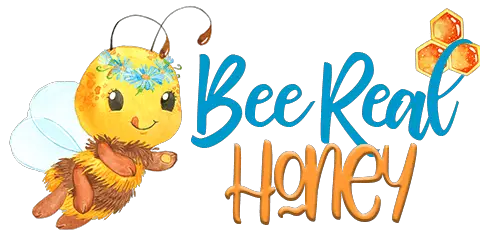*This post may have affiliate links, which means I may receive commissions if you choose to purchase through links I provide (at no extra cost to you). As an Amazon Associate I earn from qualifying purchases. Please read my disclaimer for additional details..
Bushes, or flowering shrubs, are great for your bees. Not only do they serve as foundations in your landscape, shrubs also provide plentiful foraging opportunities for bees.
So, for this post, we’re going to share the 25 best bushes for bees that you can add to your bee-attracting garden.
Table of Contents
1. Blackthorn (Prunus spinosa)
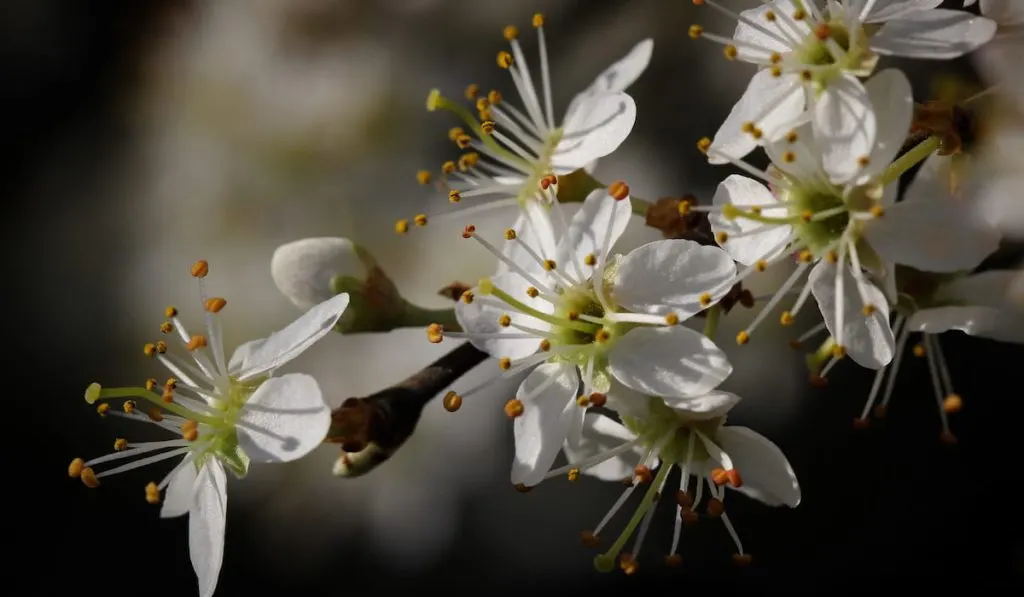
Belonging to the Rosaceae family, the Blackthorn is an excellent provider of pollen and nectar for honeybees, bumblebees, solitary bees, as well as moths and butterflies.
Blackthorn is perfect for a wildlife garden away from the house or a hedge with its thorny stems. It can grow up to 4 meters (13 feet) high if it is not kept pruned.
In spring, white flowers blossom from these shrubs, making them a valuable early-season food source for bees.
Blackthorn produces fruits, which are called sloe berries.
2. Blackberry and Raspberry Shrubs
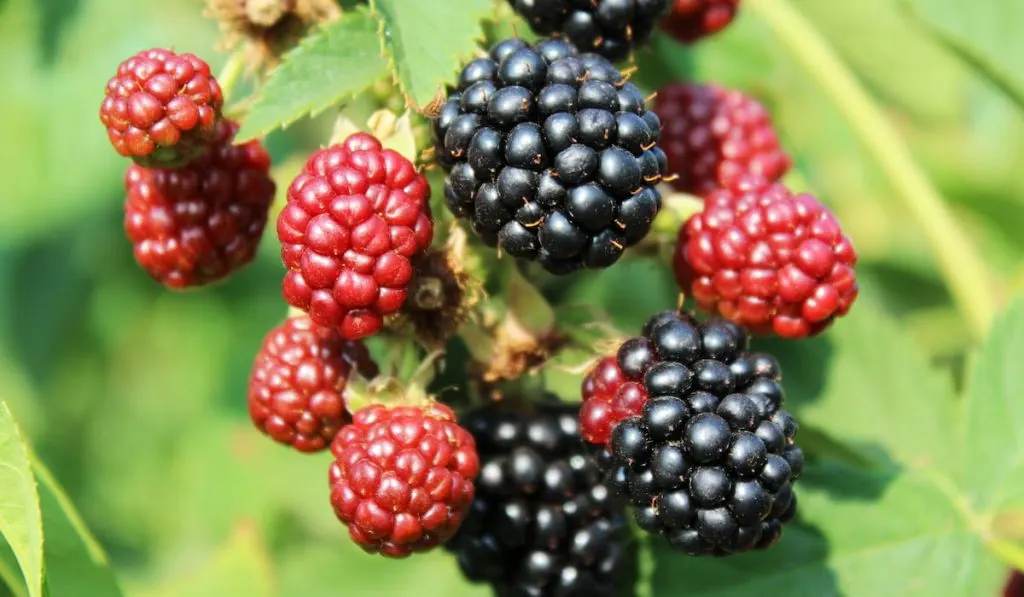
Various types of bees are attracted to berry bushes, including honeybees. Blackberries and raspberries are widely available either in wild or cultivated varieties. In addition, they are easy to grow and are highly adaptable in different locations.
If thorny berry bushes are an issue for you, thornless varieties are available. Moreover, the hollow stems of blackberry and raspberry bushes serve as a nesting area for some caterpillar species.
3. Blueberry Shrubs
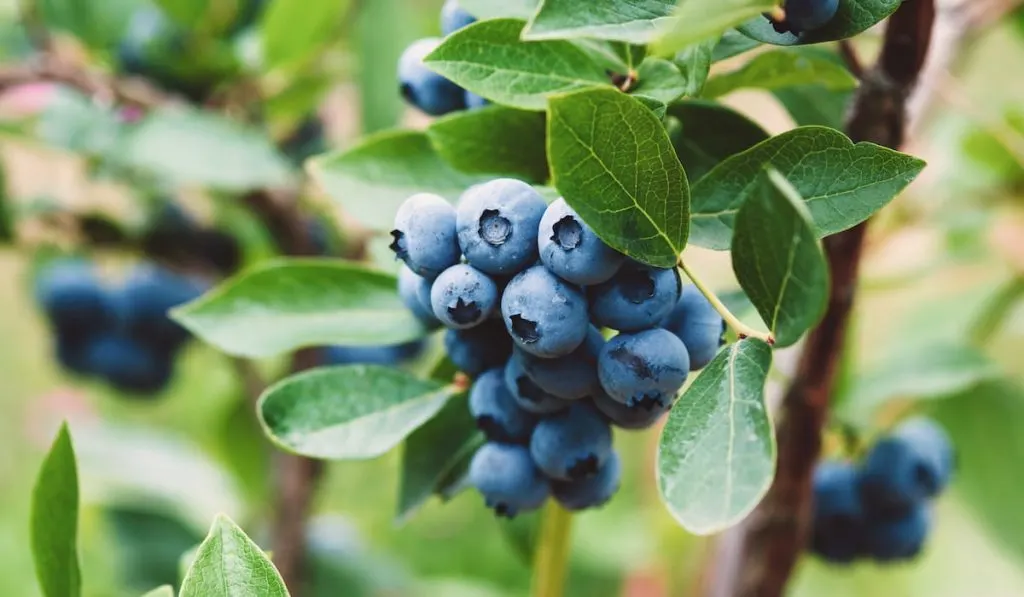
An excellent bee-friendly shrub, blueberry plants have plenty of benefits. They produce crops for humans, attract bees and provide food for them, and they can also be used for ornamental purposes.
In fall, blueberry shrubs come alive with color. They are amenable to pruning and propagation. Blueberries do need acidic soil, but once they are settled, these shrubs are very easy to maintain.
There are different varieties of blueberry shrubs available. You can choose one that fits your space and your location.
To pollinate blueberry blossoms, honeybees are commonly used. However, the large bumblebee is better at blueberry pollination compared to short-tongued honeybees.
4. Blue Mist Shrub (Caryopteris x clandonensis)
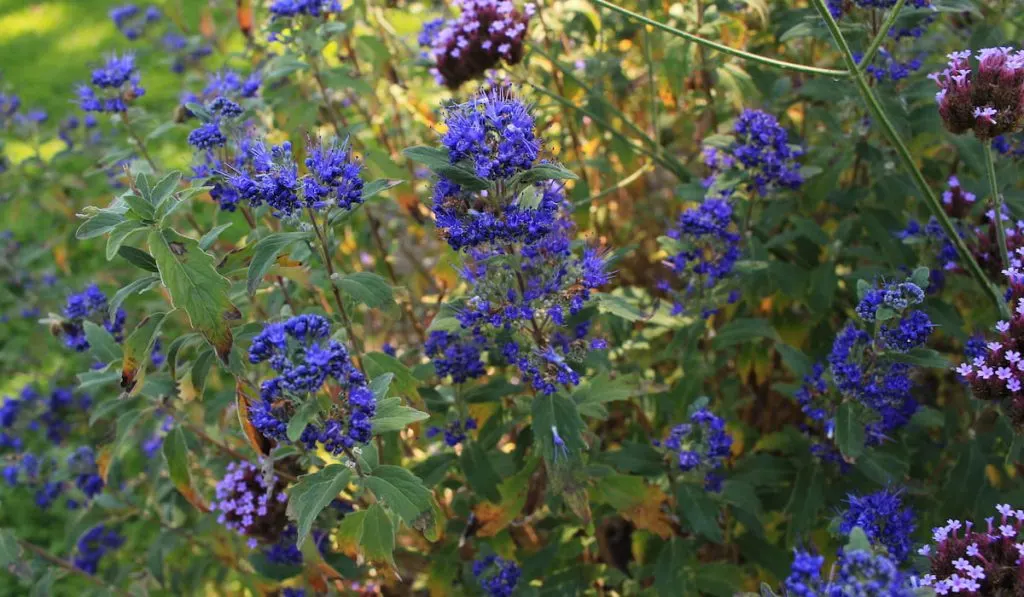
A cross between two similar plants, the Blue Mist shrub belongs to the family Lamiaceae. It is also called Bluebeard, and blue spirea.
It is one of the most striking shrubs that attract bees and other pollinators, especially during late summer through fall when it blooms from blue to purple.
Blue Mist shrub also has aromatic foliage that is green, silvery-green, white, yellow, or green in color, depending on its cultivar.
5. Butterfly Bush (Buddleia davidii)
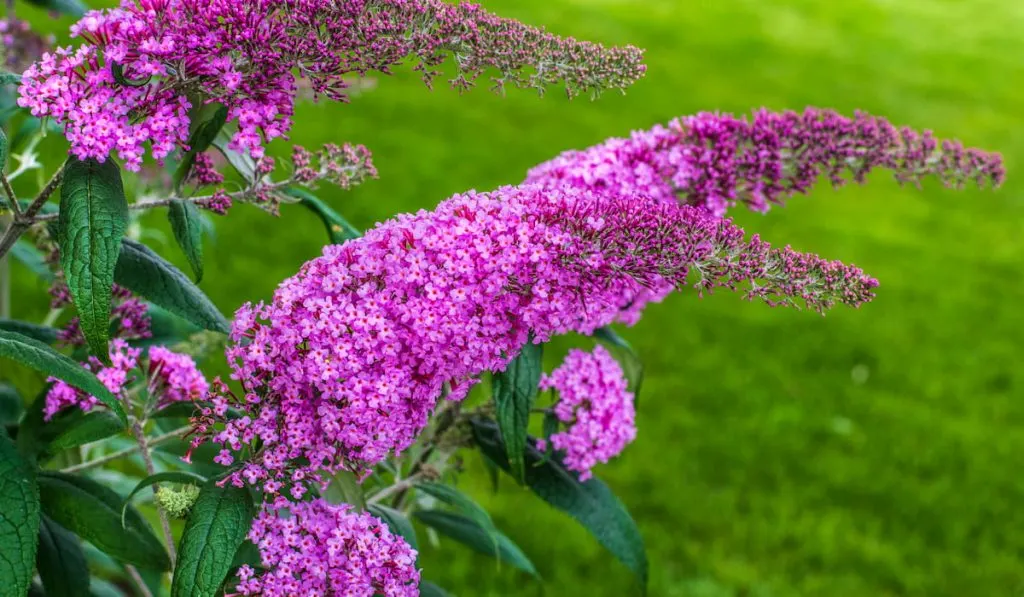
Also called ‘Buddleja’ or ‘Buddleia,’ the Butterfly bush is popular not only for butterflies but also for bees, moths, a few beetles, and sometimes, hummingbirds.
This popular hardy shrub serves as a bee food source, and they grow almost anywhere. Climbing varieties of this shrub also exist, while some can grow into trees in the right climates.
6. Buttonbush (Cephalanthus occidentalis)
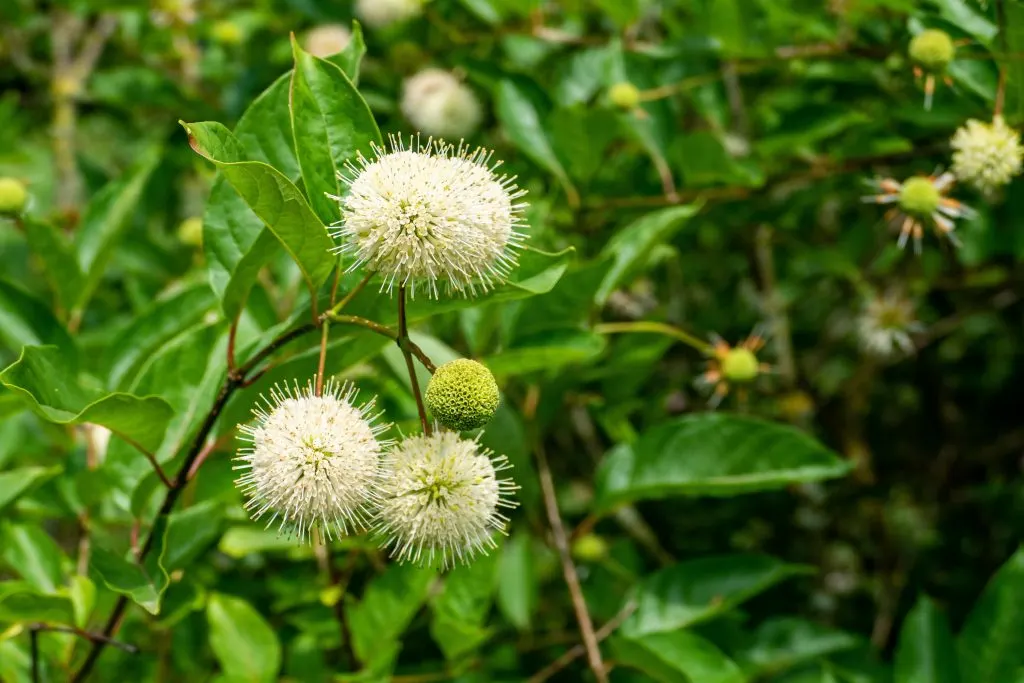
A nectar plant with yellow pollen, the Buttonbush attracts various pollinators, including bees, butterflies, and hummingbirds. Usually, bees work on the individual flower of this bush from 11 am to dusk. At night, a rich aroma is prevalent from the Buttonbush.
Buttonbush is a vital food source for pollinators. It is commonly used in bee gardens to substitute non-native butterfly bushes.
Aside from being a food source, it also serves as an ornamental shrub in fall when it turns vibrant reds and yellows. It flowers from July to September in selected locations.
It is also important to note that depending on the location, the Buttonbush can be either a large shrub or a small tree. Most often, it will be a large shrub.
They are also called by other names, including honeybells, button tree, button ball, buttonwood, and globeflower.
7. California Lilac (Ceanothus)
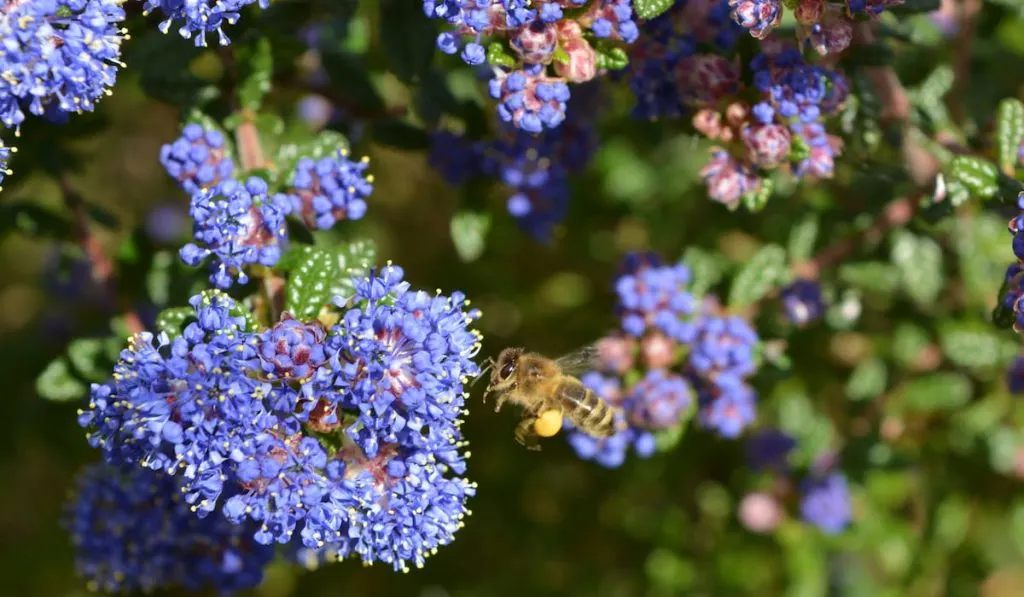
California Lilac is an excellent flowering shrub for bees. They are most highly attractive to bees in spring. The blue and pink flowers from this shrub are valued by bumblebees, honeybees, and solitary bees.
Moreover, this shrub can also tolerate extreme hot weather, such as summer drought.
They are also prized for their ornamental value. California lilacs vary in growth forms. Some are small shrubs, some are large, while others grow to be small trees.
8. Common Privet (Ligustrum vulgare)
The Common Privet is a useful addition to your bee garden. Its white flowers are usually visited by bees, butterflies, and hoverflies. Often used as a barrier hedge, the common privet also produces small, dark berries right after flowering.
One important thing to take note of about this flowering bush is that it is considered an invasive species in some countries and states, so you should check with your local garden centers before planting one.
9. Cotoneaster
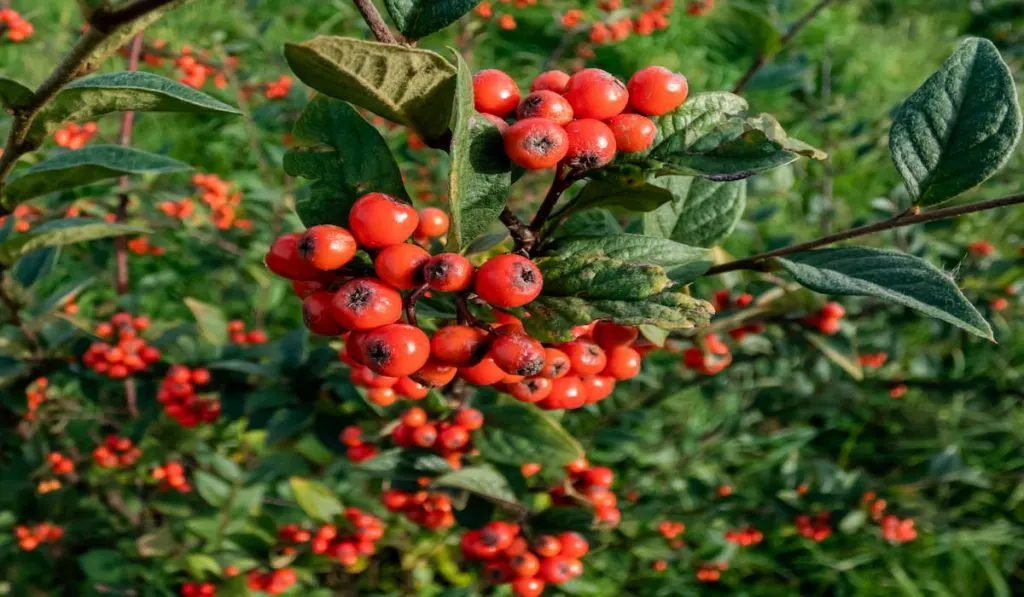
Known to attract bees and birds, the Cotoneaster splendens can either be a shrub, a dwarf plant, a tree, or an evergreen.
Originating in China, this shrub has arching branches with shiny green leaves. It blossoms in late spring, where white flowers with soft pink margins are seen.
After flowering, it bears a bright orange fruit in autumn and winter. The flowers are loved by bees because of the abundant nectar and pollen, while the fruits are eaten by birds.
Aside from being an excellent food source, the Cotoneaster is also used for ornamental purposes, or as hedges.
10. Daphne (Daphne bholua ‘Jacqueline Postill’)
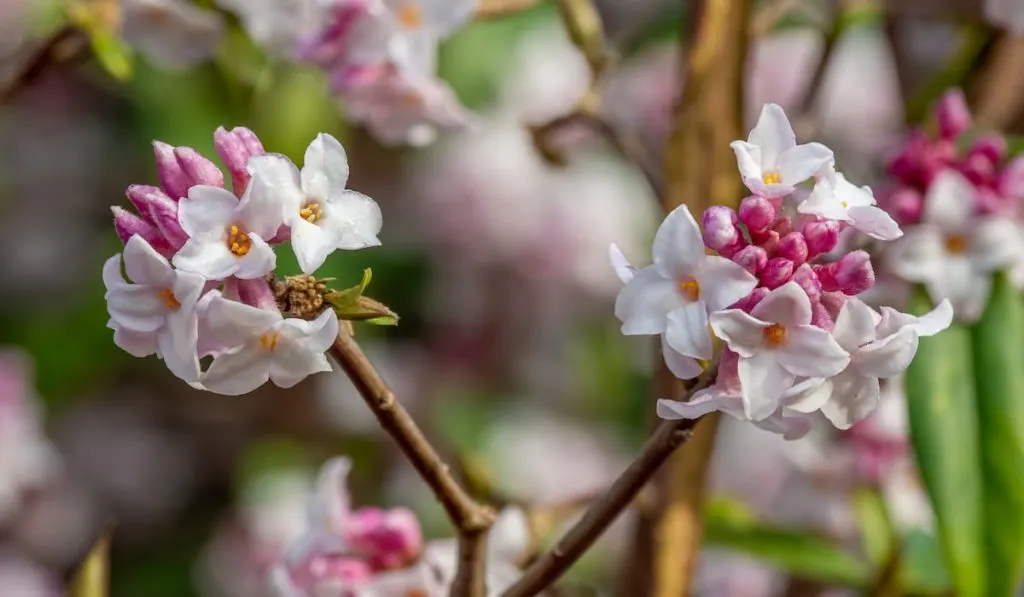
A winter-flowering shrub, Daphne is loved by bees and butterflies. It comes with a strong, fragrance that attracts pollinators to forage on their equally attractive pink flowers in cold months, such as January and February.
Daphne is a good source of pollen and nectar for queen bumblebees that need to eat after their winter snooze, and it also serves as a food source for hungry early honeybees.
11. Darwin’s Barberry (Berberis darwinii)
An evergreen flowering shrub, Darwin’s barberry produces bunches of adorable orange flowers that are loved by bees, hoverflies, and other pollinators.
Moreover, this shrub can also be used to create a dense, prickly barrier if you want to make your home more secure.
In early spring, Darwin’s barberry provides food for pollinators, especially for bumblebee queens to regain their energy and help build their colonies.
After the flower has blossomed, it is followed by the production of berries which serve as food for birds.
Sometimes, Darwin’s barberry will blossom again later in the year, although it will not be as abundant as the first blossom.
12. Red Claws (Escallonia rubra)
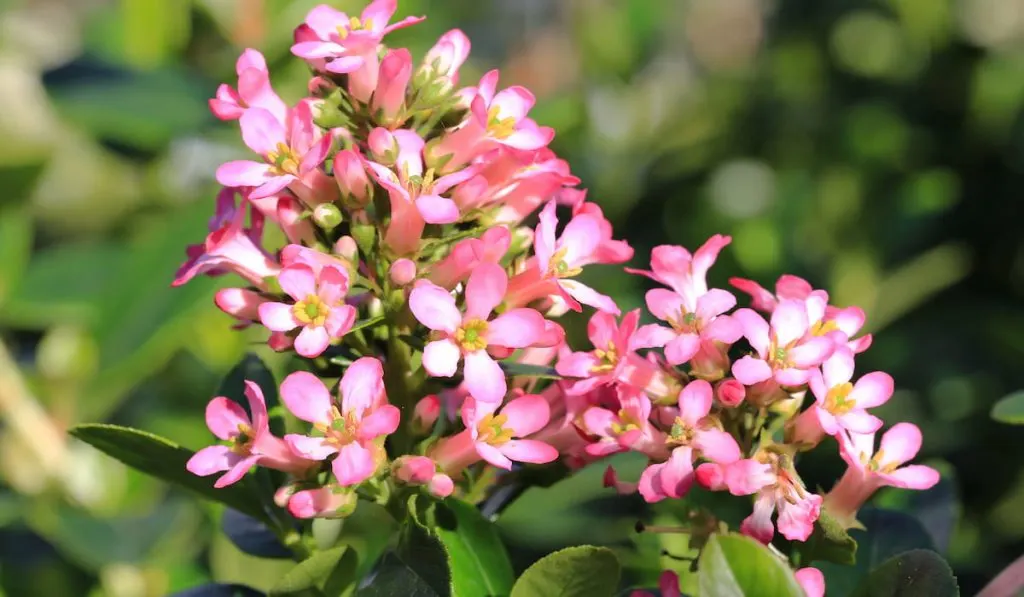
A favorite for bees, Red claws come with honey-scented flowers that are appreciated by bees, butterflies, and other pollinators in your garden. It has glossy, dark evergreen leaves, a five-petalled flower that can be red, white, or pink.
Red claws bloom from July to October with their famous trumpet-shaped flowers. This helps the shrub attract more pollinators in summer and fall.
13. Glory Flower (Clerodendrum bungei)
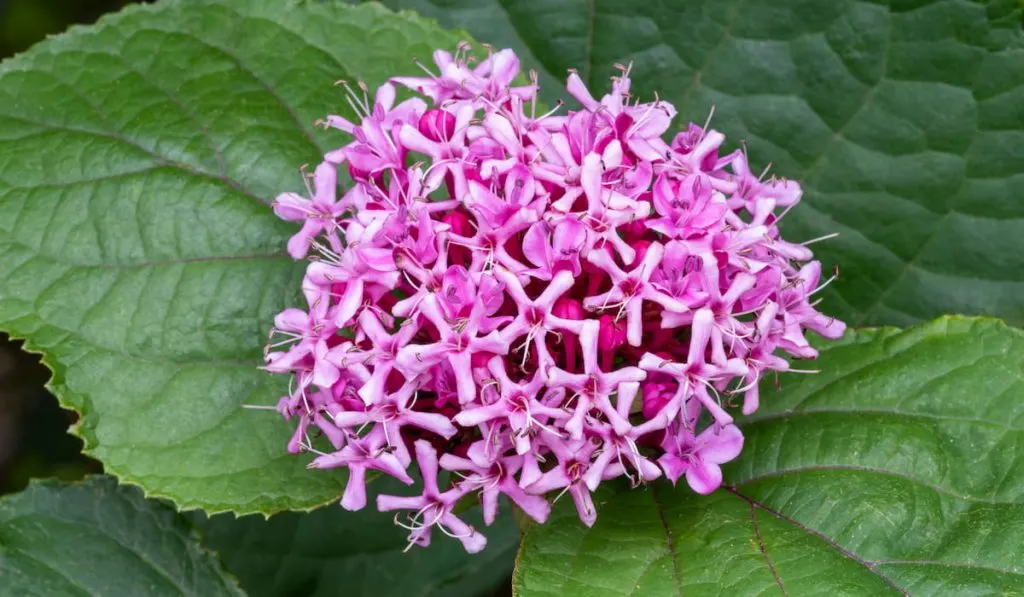
If you want an extraordinary shrub for your bee garden, the Glory flower is a great choice. This shrub comes with large green leaves and bunches of deep pink flowers with long stamens.
It has flower heads that are appreciated by bees and butterflies. In addition, the Glory flower is easy to maintain since it is quite resistant to diseases.
This shrub blooms from August to October when its ruby-red buds turn into pink, fragrant flowers.
14. Firethorn (Pyracantha)
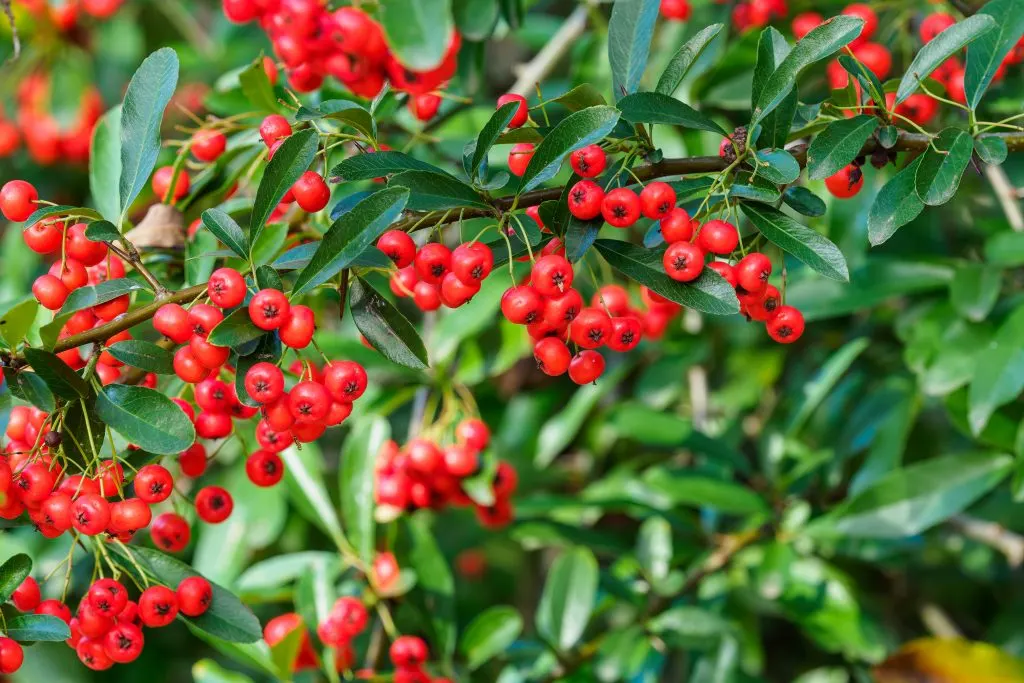
A thorny evergreen shrub, Firethorn originated in Southeast Europe and Southeast Asia. It is part of the family of roses, and it grows in more acidic, well-drained, and fertile soil.
Firethorn can be located within the landscape in full sun, or in partial shade. Also, if you have issues with security, this shrub can be a good barrier as well with its long and numerous thorns. However, they are mostly cultivated for ornamental purposes.
Firethorn flowers from May to June when it produces creamy white flowers that are in dense clusters. Its fragrant flowers are a rich source of nectar and are appreciated by bees, as well as butterflies, birds, and other pollinators.
Its berries can be red, orange, yellow, hence the name. Like its flowers, the Firethorn’s fruit are held in dense clusters that appear in autumn.
While its flowers are beneficial for pollinators, its fruit is loved by wild birds. In addition, some birds also use the branches and thorns to build their nest or to serve as a shelter in the winter.
15. Guelder Rose (Viburnum opulus)
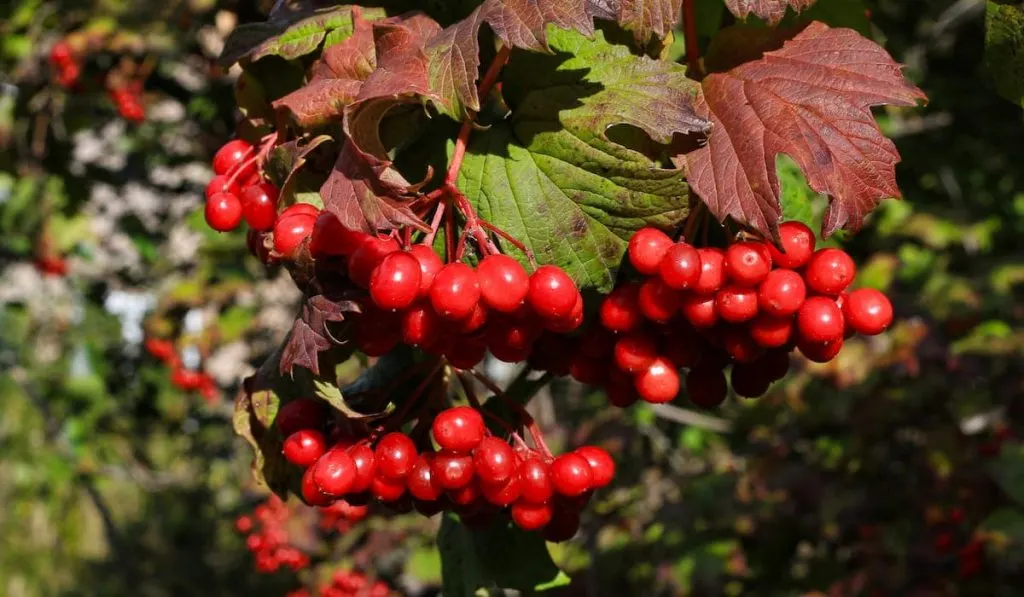
A flowering shrub that is suitable for a wildlife garden, Guelder Rose attracts bees, birds, butterflies, moths, beneficial insects, and other pollinators.
Like the other shrubs mentioned, their attractive white flowers bloom from late spring to early summer and are loved by bees and hoverflies.
The small, bright red berries that appear in autumn serve as a food for birds. In addition, their leaves also act as food for caterpillars, and they also make great wildlife hedges.
The Guelder Rose likes damp and well-drained soil. They are hardy shrubs that are suitable to grow in woodland gardens.
16. Hebe
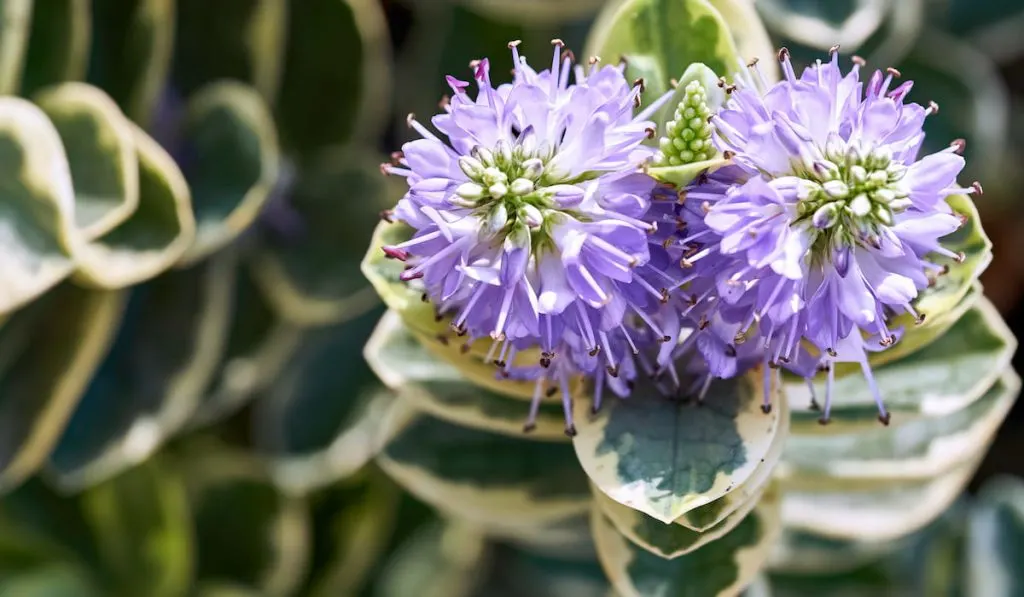
Hebes are loved by all kinds of bees.
However, not all Hebe varieties are flowering, so it is important to be careful with what you choose for your bee garden. Some may come in purple, white, or blue flowers, but they all benefit bees, hoverflies, butterflies, and other pollinators.
17. Hydrangea
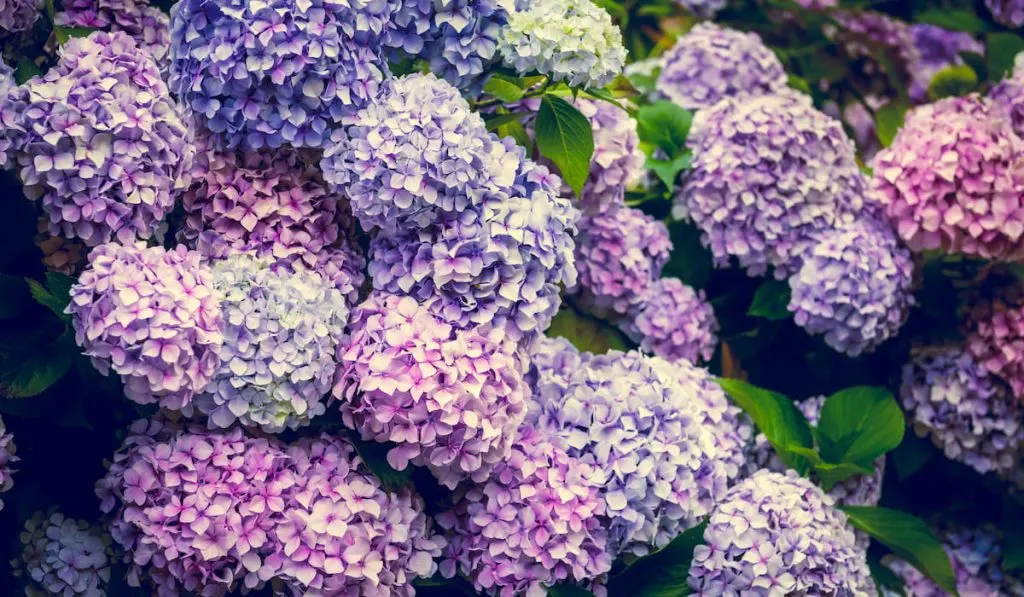
Some species of Hydrangea are appreciated by pollinators, including Hydrangea paniculata ‘Confetti’.
However, other species of Hydrangea provide no benefit for pollinators. Instead, they are only used for ornamental and decorative purposes.
Like Hebes, it is also essential to pick your Hydrangea carefully to make sure that it is one of the foraging sources for your bees.
18. Manuka Tree or New Zealand Tea Tree (Leptospermum scoparium)

This evergreen shrub is where honeybees draw from to make Manuka honey. Not only do honeybees appreciate this shrub, but they are also loved by bumblebees, different solitary bees, as well as hoverflies.
An important thing to note when growing Manuka trees or New Zealand Tea Tree is that they need a sheltered place and abundant sunshine. When it blooms, lovely pink flowers can be seen from this shrub.
19. Ninebark (Physocarpus opulifolius)
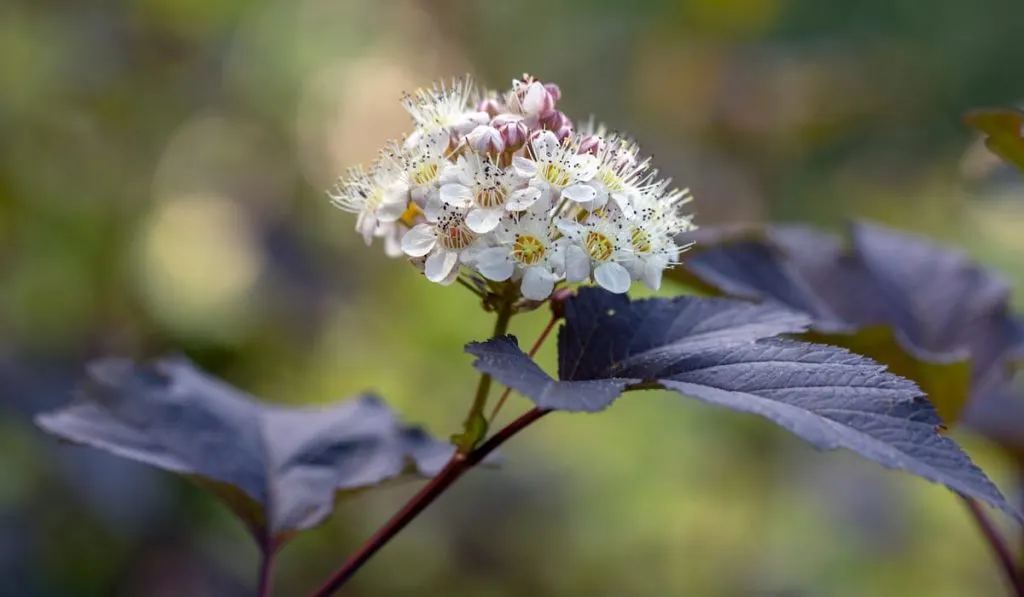
Native to central and eastern North America, Ninebark is a lovely, low-maintenance flowering shrub that attracts many pollinators to your garden.
Ninebark is part of the Rose family. It is a multi-stemmed shrub that makes a striking appearance with its arching branches that are covered with green or purple leaves. In spring and fall, white to pinkish-white flower clusters bloom from these shrubs.
Ninebark is a compact-sized, hardy shrub that has a high tolerance for lousy soils. Aside from being an excellent food source for pollinators, it also serves as a host plant for some caterpillars, including the unicorn caterpillar.
20. Oregon Grape (Mahonia)
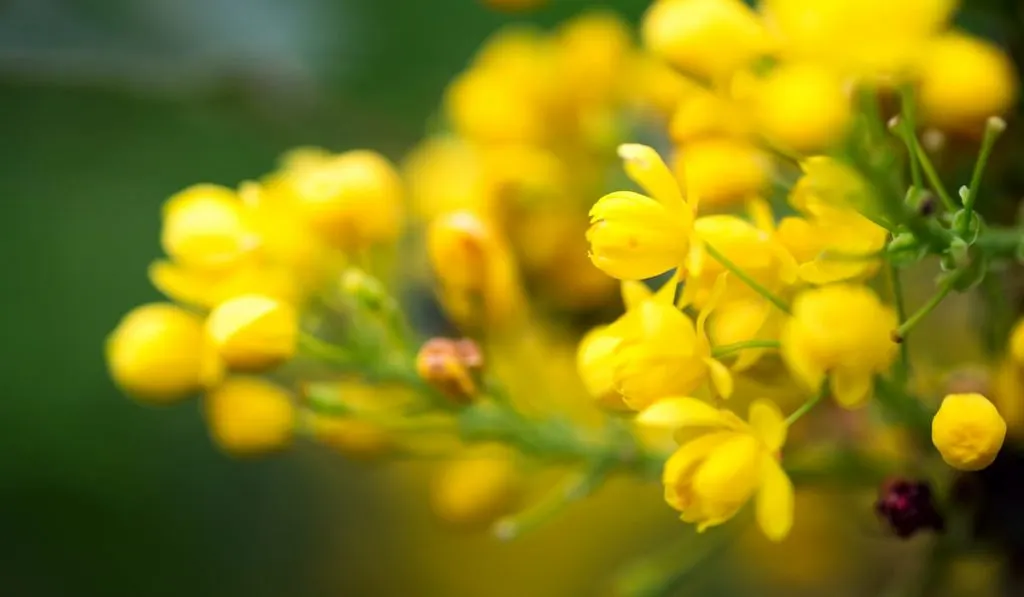
Aside from being a food source for pollinators, the Oregon Grape also makes an excellent barrier, especially if you have issues with security. It is a slow-growing evergreen shrub that has tough, spiky leaves.
The Oregon Grape comes in both native and cultivated varieties. However, the wild type is mostly used in reforestation projects.
In late winter, bright yellow, bell-shaped flowers bloom on this shrub. Because of its sweet fragrance, various pollinators are attracted to them.
After flowering, it then produces blue fruit in late summer. Their fruit serves as food for different wildlife.
21. Plum or Cherry Shrubs
Some of the best bee-friendly shrubs come from the Prunus genus, including plum and cherry shrubs.
Although most of these shrubs are used for ornamental purposes and not for their fruit, they still form pollen and nectar, which makes them a good food source for bees.
Some plum and cherry shrubs can be large, while others can grow into small trees. Regardless, they are wonderful additions to your bee garden.
However, it is essential to know that some plants from the Prunus genus may be toxic to livestock, which means that they are not recommended to be planted near grazing animals, including cows, goats, and horses.
22. Roses (Rosa)

They are certain types of roses that are appreciated by bees, including wild roses, Rosa rugosa, and more.
That said, not all roses can benefit bees and other pollinators so it is important to be careful when picking which one is best for your bee garden.
Roses come with strong fragrances, which is why they are most often visited by honeybees, bumblebees, and other solitary bees. You may also see some unfamiliar species foraging on your roses!
Not only do they make excellent sources of food for bees, but roses are also great at protecting your home from intruders because of their thorns.
23. Bridal Wreath spiraea (Spiraea japonica ‘Albiflora’)
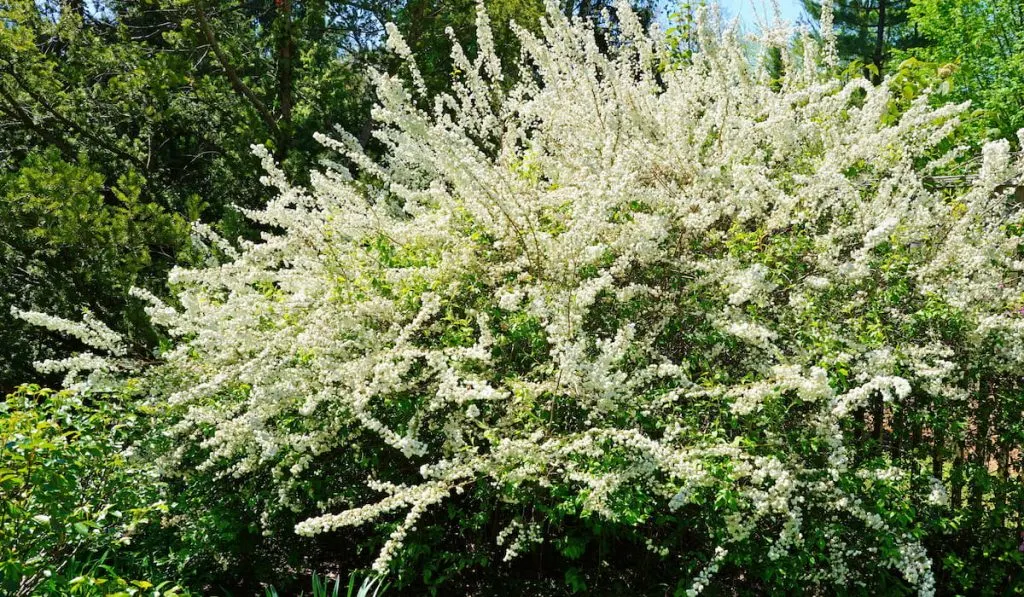
Bridal Wreath spiraea also belongs to the Rosaceae family. Its flowers are rich in nectar and pollen which attracts bees, hoverflies, beneficial insects, and other pollinators.
Its white flowers that bloom from mid-summer to autumn give this shrub a soft appearance in contrast with pale green leaves. In autumn, its leaves turn bright with red and purple hues.
This shrub thrives in moist but well-drained soil with direct sunlight or partial shade.
24. St. John’s Wort (Hypericum)

St. John’s Wort provides abundant pollen for different species of bees. It is a flowering shrub that comes in many species, including Hypericum perforatum, Hypericum subsessile, Hypericum monogynum, Hypericum grandiflorum, Hypericum androseamum, and Hypericum olympicum.
A cheerful yellow flower adorns these shrubs from summer through autumn, followed by berries that can be yellow, green, red, or brown. Their seeds are also eaten by certain birds.
However, the best thing about this is when you watch chubby bumblebee queens and other large workers landing and bouncing on the stamens of St. John’s Wort.
Aside from bumblebee queens, honeybees, other solitary bees, and hoverflies can also be seen foraging on these shrubs.
St. John’s Wort is easy to grow and maintain due to the fact that it is resistant to most plant diseases, but may still develop a condition called Hypericum rust. They thrive in an open, sunny spot where there is enough space for them to spread.
25. Willows (Salix)

One of the earliest food sources for bees and other pollinators, willows bloom in early spring.
Although male and female blooms emerge from different plants, it still produces nectar for bees to forage. However, it is important to note that only male willow flowers create pollen for bees.
Various types of willows exist, but they are all easy to grow, maintain and propagate. Pussy willows are a great variety of this shrub for bees while weeping willow trees and other fancy hybrids only give minimal benefit to pollinators.
You may also plant them in a thicket, or as a dense group to serve as a food source and shelter for insects as well.
In Conclusion
You may now have realized that there are many colorful and easy-to-grow shrubs that are beneficial for your bees, birds, and other pollinators.
They don’t only serve as a food source and a shelter for such creatures, but they also help create a beautiful landscape for your property.
Resources:
- https://www.buzzaboutbees.net/Flowering-Shrubs-For-Bees.html
- https://savvygardening.com/shrubs-for-pollinators-bees-butterflies/
- https://carolinahoneybees.com/bushes-for-bees/
- https://www.northumbrianbees.co.uk/plants_for_bees/blackthorn/
- https://www.gardeningknowhow.com/ornamental/shrubs/blue-mist-shrub/caryopteris-blue-mist-shrubs.htm
- https://www.buzzaboutbees.net/Buddleia-for-bees-and-butterflies.html
- https://www.beeculture.com/button-bush/
- https://nativebeeology.com/2018/08/18/buttonbush-a-midseason-favorite/
- https://www.buzzaboutbees.net/A-Fragrant-Winter-Flowering-Shrub-For-Bees-Daphne-bholua.html
- https://static1.squarespace.com/static/
- https://www.gardenersworld.com/plants/cotoneaster-splendens/
- https://horticulture.co.uk/escallonia/
- https://www.softschools.com/facts/plants/firethorn_facts/1760/
- https://www.gardenersworld.com/plants/viburnum-opulus/
- https://www.gardenersworld.com/plants/spiraea-japonica-albiflora/
- https://www.buzzaboutbees.net/bees-like-hypericum.html
